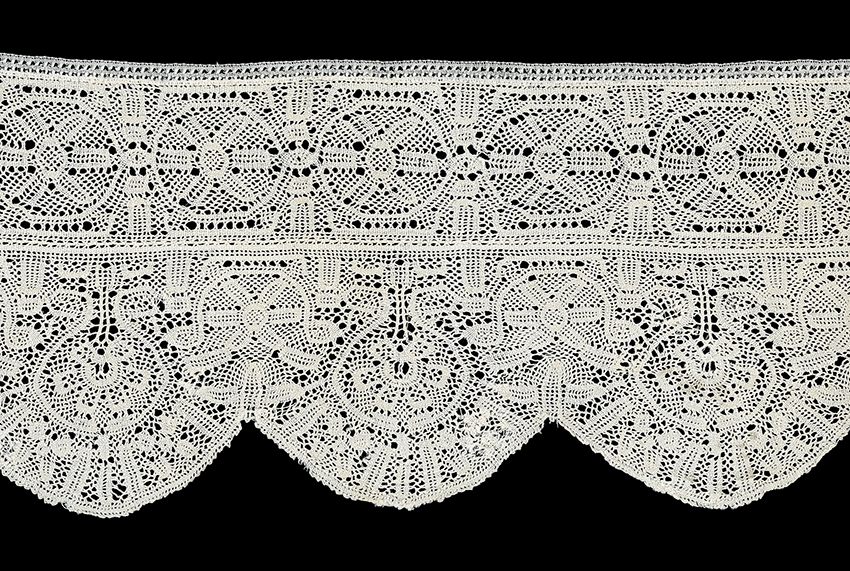|
Spanish Huelva border
15 cm x 180 cm
Very good condition. Four of the scallop edges are frayed, three repaired. Minor fraying along lower edge elsewhere, occasional broken thread near the scallops. One repair along the top of the insertion, 2-3/4" x 1" located 11.5" from one end, combination needle and bobbinlace patch. The upper edge appears intact, but it's hard to tell since the engrelure is complex and sewn over the edge. One end cut, the other end partially folded over and hemmed.
Working: Linen , 2 ply S single Z, rather loosely plyed. Averages 0.374 mm diameter.
Engrelure: Cotton, 2 ply S single Z. Averages 0.163 mm diameter.
This is a highly geometric bobbinlace, perhaps freehand. The top insertion and bottom scalloped piece are carefully sewn together with overcasting, although the patterns align about every 11 repeats of the top insertion. A modern cotton engrelure is added at the top. Probably an 18th c piece. Difficult to tell back from front. This is an unusual, rare piece.
From Frieda Sorber (email dated April 15, 2021):
I think your seller was correct in calling this Spanish. In general appearance it resembles the so called punta laces exported from Antwerp over Cadiz to Middle and South America in the 17th and 18th centuries. This sparked copying locally in the Cadiz hinterland and possibly also in France, notably Le Puy on the pilgrim road to Compostella. We know little of actual production around Le Puy in the 18th cent. But documents seem to point in that direction. Museum collections in Le Puy and surroundings don't seem to have anything older than 19th cent. Your piece is almost certainly Huelva. There may be similar pieces in Florence Lewis May's book (lsw note - was unable to find a similar piece in Florence May's "Hispanic Lace and Lace Making". She also wrote a catalog of pieces in the Hispanic Society - look this up). I saw similar pieces she collected at the Hispanic society in NY. Typical is the fairly linear style of the designs. Local lace makers used coarser threads and did not quite master the way to make more rounded shapes like in Flanders. If May's info in the NY museum is correct she collected in churches in the Huelva area. There is no reason to doubt her. Whereas in Antwerp the lace would be in one piece the Spanish makers made scalloped border and straight heading separately.
I think I remember this piece from the Minnesota Museum of Art - look it up.
purchased 03/02/2021
first posted 04/17/2021
|
